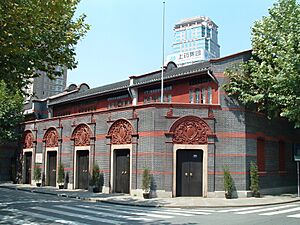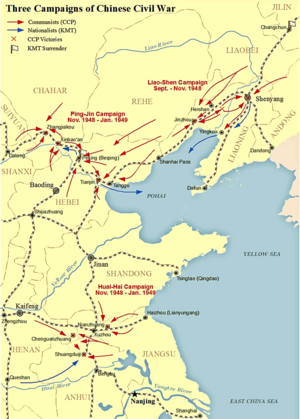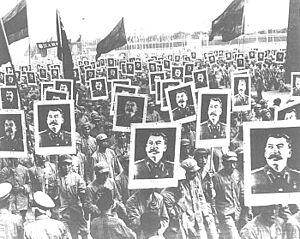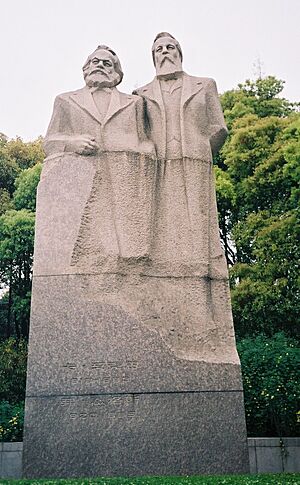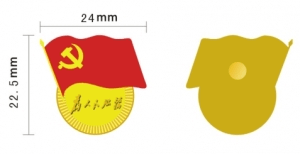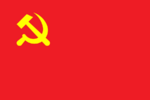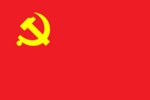Chinese Communist Party facts for kids
Quick facts for kids
Communist Party of China
中国共产党
Zhōngguó Gòngchǎndǎng |
|
|---|---|
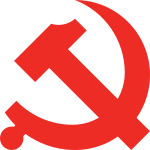 |
|
| Abbreviation | CCP (common) CPC (official) |
| General Secretary | Xi Jinping |
| Standing Committee |
|
| Founders |
... and others
1st National Congress representatives:
Henk Sneevliet Vladimir Neumann Li Da Li Hanjun Zhang Guotao Liu Renjing Mao Zedong He Shuheng Dong Biwu Chen Tanqiu Wang Jinmei Deng Enming Chen Gongbo Zhou Fohai Bao Huiseng |
| Founded |
|
| Headquarters | Zhongnanhai, Xicheng District, Beijing |
| Newspaper | People's Daily |
| Youth wing | Communist Youth League of China |
| Children's wing | Young Pioneers of China |
| Armed wing |
|
| Research office | Central Policy Research Office |
| Membership (2023) | |
| Ideology |
Socialism with Chinese characteristics
Communism
Marxism–Leninism Mao Zedong Thought Deng Xiaoping Theory Three Represents Scientific Outlook on Development Xi Jinping Thought |
| International affiliation | IMCWP |
| Colours | Red |
| Slogan | "Serve the People" |
| National People's Congress (13th) |
2,090 / 2,980
|
| NPC Standing Committee (14th) |
117 / 175
|
| Party flag | |
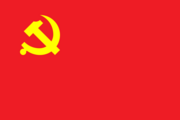 |
|
| Communist Party of China | |||||||||||||||||||||||
|---|---|---|---|---|---|---|---|---|---|---|---|---|---|---|---|---|---|---|---|---|---|---|---|

"Communist Party of China" in simplified (top) and traditional (bottom) Chinese characters
|
|||||||||||||||||||||||
| Chinese name | |||||||||||||||||||||||
| Simplified Chinese | 中国共产党 | ||||||||||||||||||||||
| Traditional Chinese | 中國共產黨 | ||||||||||||||||||||||
| Hanyu Pinyin | Zhōngguó Gòngchǎndǎng | ||||||||||||||||||||||
|
|||||||||||||||||||||||
| Abbreviation | |||||||||||||||||||||||
| Chinese | 中共 | ||||||||||||||||||||||
| Hanyu Pinyin | Zhōnggòng | ||||||||||||||||||||||
|
|||||||||||||||||||||||
| Tibetan name | |||||||||||||||||||||||
| Tibetan | ཀྲུང་གོ་གུང་ཁྲན་ཏང | ||||||||||||||||||||||
|
|||||||||||||||||||||||
| Zhuang name | |||||||||||||||||||||||
| Zhuang | Cunghgoz Gungcanjdangj | ||||||||||||||||||||||
| Mongolian name | |||||||||||||||||||||||
| Mongolian Cyrillic | Дундад улсын (Хятадын) Эв хамт (Kоммунист) Нам | ||||||||||||||||||||||
| Mongolian script | ᠳᠤᠮᠳᠠᠳᠤ ᠤᠯᠤᠰ ᠤᠨ (ᠬᠢᠲᠠᠳ ᠤᠨ) ᠡᠪ ᠬᠠᠮᠲᠤ (ᠺᠣᠮᠮᠤᠶᠢᠨᠢᠰᠲ) ᠨᠠᠮ |
||||||||||||||||||||||
|
|||||||||||||||||||||||
| Uyghur name | |||||||||||||||||||||||
| Uyghur | جۇڭگو كوممۇنىستىك پارتىيىسى | ||||||||||||||||||||||
|
|||||||||||||||||||||||
| Manchu name | |||||||||||||||||||||||
| Manchu script | ᡩᡠᠯᡳᠮᠪᠠᡳ ᡤᡠᡵᡠᠨ ᡳ (ᠵᡠᠨᡤᠣ ᡳ) ᡤᡠᠩᡮᠠᠨ ᡥᠣᡴᡳ |
||||||||||||||||||||||
| Romanization | Dulimbai gurun-i (Jungg'o-i) Gungcan Hoki | ||||||||||||||||||||||
The Chinese Communist Party (CCP), also known as the Communist Party of China (CPC), is the main political party in China. It is the only party that rules the People's Republic of China (PRC). The CCP has been in charge of China since 1949. It also controls the country's army, called the People's Liberation Army (PLA).
The party's ideas are based on socialism with Chinese characteristics. This means they combine socialist principles with China's unique situation. As of 2024, the CCP has over 99 million members. This makes it the second largest political party in the world.
The CCP was started in 1921 by Chen Duxiu and Li Dazhao. They got help from the Russian Communist Party. At first, the CCP worked with another party called the Kuomintang (KMT). But later, the KMT, led by Chiang Kai-shek, attacked the CCP. This led to a long Chinese Civil War. During this war, Mao Zedong became a very important leader in the CCP. He gained support from farmers by changing land rules.
After the Second Sino-Japanese War ended in 1945, the CCP won the civil war against the KMT. The KMT leaders moved to Taiwan. On October 1, 1949, Mao Zedong announced the creation of the People's Republic of China.
Mao Zedong was the most powerful leader of the CCP until he passed away in 1976. Under his leadership, China made big changes, like land reform and five-year plans for the economy. After Mao, Deng Xiaoping became a key leader. He changed the party's focus to economic reforms, allowing more market-based ideas. He said that China was in an early stage of socialism. After the dissolution of the Soviet Union in 1991, the CCP focused on keeping ties with other socialist countries. It also built relationships with non-communist parties around the world.
The Chinese Communist Party is organized using a system called democratic centralism. This means that members can discuss policies openly. But once a decision is made, everyone must support it. The highest group in the CCP is the National Congress, which meets every five years. When it's not meeting, the Central Committee is in charge. However, most daily work is done by the Politburo and its Standing Committee. The members of the Standing Committee are seen as the top leaders of China. The current leader is Xi Jinping. He is the general secretary of the party, the head of the military, and the country's president.
Contents
History of the Chinese Communist Party
How the CCP Started
The ideas of Marx and the October Revolution in Russia inspired the CCP's beginning. Chen Duxiu and Li Dazhao were early supporters of these ideas in China. They believed the Russian Revolution showed a new path for countries facing challenges.
The May Fourth Movement in 1919 also played a big role. This movement was about social change and Chinese pride. It helped create a group of thinkers who later helped form the CCP. The CCP sees itself as part of this movement's history.
The CCP officially began on July 1, 1921. Its first meeting, the 1st National Congress, happened from July 23 to 31, 1921. It started in a house in Shanghai but had to move to a boat on South Lake because of police. At this meeting, they decided to form a communist party and chose Chen Duxiu as its first leader.
The Soviet Union wanted to support groups in East Asia that were friendly to them. They helped the CCP and also connected with the Kuomintang (KMT). The CCP hoped to gain influence within the KMT. The KMT leader, Sun Yat-sen, helped ease tensions between the two parties. After 1925, the CCP grew quickly.
Civil War and War with Japan
In 1927, the KMT leader, Chiang Kai-shek, turned against the communists. He ordered attacks on CCP members in cities like Shanghai. This led to a full split between the two parties. The CCP then formed its own army, the Workers' and Peasants' Red Army of China, also known as the "Red Army."
On August 1, 1927, General Zhu De led an uprising in Nanchang. This was a key moment for the Red Army. Later, Mao Zedong led an uprising in Hunan. Even though these early efforts faced difficulties, Mao became a strong leader. The party learned to organize better and gained more power.
In 1936, the CCP and KMT agreed to stop fighting each other. They formed a Second United Front to fight against the Japanese invaders. This alliance lasted until 1945. During this time, the CCP used the chance to grow its influence and prepare for the civil war that would likely restart.
After Japan surrendered in 1945, the civil war between the CCP and KMT began again. At first, the KMT had more soldiers. But their rule was not popular because of problems like corruption. The CCP gained support in rural areas and from the Soviet Union. By 1948, the KMT's army was much weaker. The CCP launched big attacks and won many battles. On October 1, 1949, Mao Zedong announced the founding of the People's Republic of China. This marked the end of the civil war.
China Under CCP Rule (1950s-1970s)
After 1949, the CCP became the sole ruling party in China. In 1957, the party launched a campaign against people who disagreed with its policies. This made China a one-party state.
The "Great Leap Forward" (1958-1962) was a plan to quickly change China from a farming country to an industrial one. The CCP tried to organize farms into communes and move workers to factories. However, this plan led to a very difficult time for the country, causing a large famine.
In the 1960s, the CCP and the Soviet Union had different ideas, leading to a split. Mao Zedong then started the Cultural Revolution. This was a big movement to remove people he saw as "capitalist" or "reactionary" from the party. Many people faced difficulties during this time.
Reforms and Modernization (1970s-2000s)
After Mao's death in 1976, Deng Xiaoping became China's top leader. He started the "reform and opening-up" policies. This meant China began to open its economy to the world. Deng believed that a socialist country could use market ideas to grow. These changes led to huge economic growth for China. His ideas, called "Deng Xiaoping Theory," became part of the CCP's rules.
Later, Jiang Zemin and Hu Jintao continued these reforms. Jiang introduced the "Three Represents" idea, which allowed business owners to join the party. Hu Jintao focused on "Scientific Outlook on Development" and a "Harmonious Society" to deal with social problems that came with fast economic growth.
Xi Jinping's Leadership
Since Xi Jinping became leader in 2012, he has started a big campaign against corruption. He has also made the role of the CCP general secretary stronger. His own ideas, called "Xi Jinping Thought," were added to the party's constitution in 2017. Xi Jinping's leadership was renewed in 2022.

In 2021, the CCP celebrated its 100th anniversary. Xi Jinping also hosted a meeting with political parties from around the world. He encouraged them to work together for a shared future.
CCP's Main Ideas
Official Ideology
The CCP's main ideas have changed over time with each new generation of leaders.
- Marxism–Leninism: This was the first official idea. It talks about how human societies develop and how capitalism might lead to socialism.
- Mao Zedong Thought: This is Marxism–Leninism adapted for China. It was developed by Mao Zedong and other party leaders.
- Deng Xiaoping Theory: Added in 1992, this idea says that a socialist country can use market methods. It focuses on finding what works best for China's development.
- Three Represents: Introduced by Jiang Zemin, this idea says the party must represent advanced production, advanced culture, and the interests of the Chinese people. It allowed business owners to join the party.
- Scientific Outlook on Development: Hu Jintao's idea, focusing on balanced and sustainable development, social welfare, and a more harmonious society.
- Xi Jinping Thought: Added in 2017, this is Xi Jinping's contribution to the party's ideas. It includes goals for China's future and the party's role.
The party combines ideas of socialist patriotism (love for a socialist country) and Chinese nationalism (pride in China).
Economic Ideas
Deng Xiaoping believed that a planned economy was not the only way for socialism. He said that both planning and market forces could be used to manage the economy. Jiang Zemin agreed, saying that what mattered was whether a method worked, not if it was called "socialist" or "capitalist." This led to the idea of a "socialist market economy."
The CCP believes that socialism will eventually succeed over capitalism. They see globalization (the world becoming more connected) as something that can help socialism, even though it developed under capitalism.
How the CCP is Organized
Central Organization
The National Congress is the CCP's highest meeting. It happens every five years. Its jobs include choosing the Central Committee and discussing party policies.
Between these congresses, the Central Committee is the main decision-making body. It chooses the party's leader, the general secretary, and other important groups like the Politburo and the Politburo Standing Committee (PSC). The PSC is the party's highest decision-making group when other bodies are not meeting.
The Central Military Commission (CMC) handles military matters and controls the People's Liberation Army. The general secretary is also the head of the CMC.
The CCP has several important departments. For example, the Organization Department handles appointments, and the Publicity Department manages media and party messages. The International Department deals with other political parties around the world. The party also controls major news outlets like the People's Daily newspaper and China Media Group (which includes CCTV).
Local Organizations
The CCP has committees at every level of government, including provinces, cities, and neighborhoods. These committees help guide local policies and choose local leaders. The party secretary at each level is usually more powerful than the head of the local government.
CCP committees also exist inside companies, both private and state-owned. If a business has more than three party members, it is legally required to have a party branch. These branches help new members and organize events. They also help companies understand government policies.
Party Members
At the end of 2023, the CCP had over 99 million members. It is the second largest political party in the world. To join the CCP, adults apply to their local party branch. There's a check of their background and political views. If accepted, they spend a year as a probationary member before becoming full members. Many people also join through the Communist Youth League.
Today, the CCP looks for members with good education and technical skills. Over half of party members have a college degree or higher. Being a CCP member can offer benefits, like higher wages.
Women in the Party
As of 2023, about 30% of CCP members are women. However, women are not as often in the most powerful political positions. No woman has ever been part of the Politburo Standing Committee, and currently, there are no female members in the broader Politburo.
Communist Youth League
The Communist Youth League of China (CYL) is the CCP's youth group. Young people aged 14 to 28 can join. The CYL also oversees the Young Pioneers of China, which is for children under 14. The CYL's structure is similar to the CCP's. It works under the guidance of the CCP leadership. In 2021, the CYL had over 81 million members.
Party Symbols
The official flag of the CCP was set in 1942. It is red with a hammer and sickle symbol in the top-left corner. The red color stands for revolution. The hammer and sickle are tools of workers and farmers, showing that the party represents their interests. The yellow color means brightness.
CCP's International Relations
The CCP's International Department of the Chinese Communist Party talks with political parties around the world.
Relations with Communist Parties
The CCP keeps in touch with other communist and workers' parties globally. It attends international meetings of these parties. This includes parties in countries like Portugal, France, Russia, and Nepal.
Relations with Ruling Socialist Parties
The CCP has close ties with the ruling parties in other socialist countries, such as Cuba, Laos, North Korea, and Vietnam. The CCP studies why these countries have remained socialist. For example, they see Vietnam's economic reforms as a good model.
The CCP also has a lot of interest in Cuba and its revolution. They admire leaders like Fidel Castro. They have increased communication with Cuba's Communist Party.
Relations with Non-Communist Parties
Since the 1990s, the CCP has also started building relationships with non-communist parties. They do this to learn from them. For example, they study how the People's Action Party in Singapore stays in power. They also look at parties like the United Malays National Organization in Malaysia and the Liberal Democratic Party in Japan.

The CCP has also shown interest in Latin American parties. They studied the Institutional Revolutionary Party (PRI) in Mexico, which ruled for a long time. They also have ties with socialist parties in Latin America.
Since the 1980s, the CCP has been interested in social democratic parties in Europe. They have learned from how these parties adapted and changed their policies.
Electoral History
National People's Congress Elections
The CCP is the ruling party in China, and its members hold most seats in the National People's Congress.
| Election | General Secretary | Seats | +/– | Position |
|---|---|---|---|---|
| 1982–1983 | Hu Yaobang |
1,861 / 2,978
|
||
| 1987–1988 | Zhao Ziyang |
1,986 / 2,979
|
||
| 1993–1994 | Jiang Zemin |
2,037 / 2,979
|
||
| 1997–1998 |
2,130 / 2,979
|
|||
| 2002–2003 | Hu Jintao |
2,178 / 2,985
|
||
| 2007–2008 |
2,099 / 2,987
|
|||
| 2012–2013 | Xi Jinping |
2,157 / 2,987
|
||
| 2017–2018 |
2,119 / 2,980
|
|||
| 2022–2023 |
See also
 In Spanish: Partido Comunista de China para niños
In Spanish: Partido Comunista de China para niños
- Politics of China
- Succession of power in China


